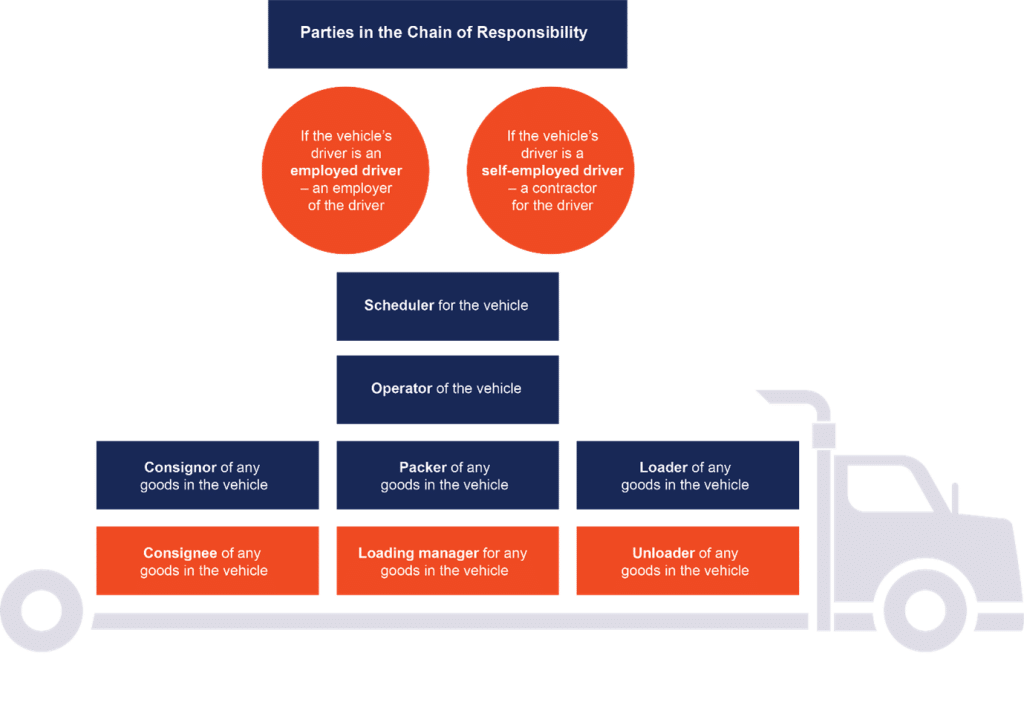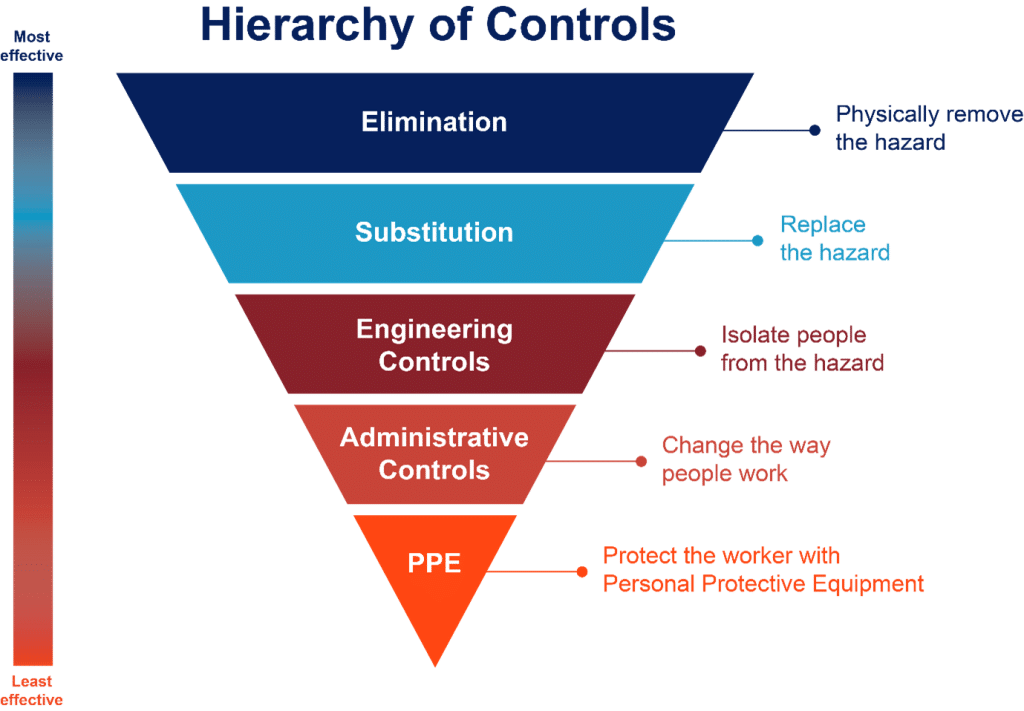Trucks in my business? How risky can it be?
 6 mins reading time
6 mins reading time
What is the Chain of Responsibility?
It’s been six years since the introduction of the Heavy Vehicle National Law (HVNL) established the Chain of Responsibility (COR) obligations for all parties who play a role in the logistics supply chain. In more recent times, we have seen an increase in enforcement activities at a national level which has resulted in jail sentences for individuals, other than drivers and this trend looks set to continue.
In March this year, we produced an Insight that delves into how the National Heavy Vehicle Regulator has changed. At a high level, in May 2017 the National Heavy Vehicle Regulator (NHVR) established the COR which legislated a primary duty of safety for vehicles that are 4.5 tonnes or more. Many vehicles have a Gross Vehicle Mass (GVM) of 4.5 tonnes. By way of example, some of the larger utility vehicles have a GVM nudging in at 4.5 tonnes, and many vehicles towing a caravan or carrying a heavy load will have a GVM of more than 4.5 tonnes.
The obligation requires all parties in the COR to ensure so far as reasonably practicable, the safety of transport activities (Primary Duty). These changes affect any State or Territory in Australia, except Western Australia and the Northern Territory.
Recent case law has highlighted the extent of the Primary Duty reaching managers and executives. The maximum penalties for breaches of the Primary Duty for executives are:
- $300,000 and/or up to five years imprisonment for conduct that recklessly exposes a person to risk of injury;
- $150,000 for conduct that exposes a person to risk of injury; and
- $50,000 for conduct that breaches the executive duty.
Who is a ‘party’ in the COR?
A ‘party’ is any person who is involved in the operation of vehicles weighing in excess of 4.5 tonnes that transport goods. The legislation focuses on a granular examination of the everyday duties of the employee rather than the job title or position description in isolation.
For executives of businesses, the HVNL imposes a positive duty of due diligence (Positive Duty). Under section 5 of the HVNL, an ‘executive’ extends to any person who is concerned with or takes part in the management of a corporation. The Positive Duty requires executives to perform their due diligence and ensure that the business is complying with their Primary Duty.

What are the duties of everyone in the COR?
The NHVL requires parties of the COR to ensure, so far as reasonably practicable, that their vehicles and drivers are safe on the road. Vehicles should be consistently monitored to ensure that they are maintained in working order and meet the minimum design and safety requirements before being driven on the road.
‘Reasonably practicable’ is assessed by considering:
- the likelihood of a risk to safety and/or road infrastructure and the potential harm;
- the party’s knowledge of the risk and available controls (including reasonably assumed knowledge); and
- the practicability of implementing the control strategies to eliminate or minimise the hazards and risks arising.
It is critical that all parties in the COR consult with each other about the risks and undertake a comprehensive risk assessment (on a continuous basis) of the current hazards and risks, and verify and validate the implementation of any risk controls.
What are the duties of executives?
The Positive Duty imposed on executives requires them to ensure:
- they have sufficient and up-to-date knowledge on:
- the business’s transport activities;
- the potential hazards and risks involved in transport activities; and
- how to implement safe transport activities;
- access to resources regarding eliminating and minimising the risks and hazards associated with transport activities are easily accessible by the business and any employees in the COR;
- the business is implementing processes to eliminate or minimise the risks and hazards and have the information available for the steps involved if there is an incident.
For example, executives can assist in reducing the risk of drivers in the business feeling pressure to speed or to drive while fatigued by allowing for adequate timeframes when preparing schedules for loading and dispatching the vehicles.
Hierarchy of Control
It is recommended that businesses implement a control system to effectively manage and minimise risks. The “Hierarchy of Control’ (Hierarchy) methodology ranks the control methods by reference to the level of protection and reliability of each elimination/minimisation process.
The Hierarchy is as follows:

Key Takeaways
- It is not just the party operating the vehicle that is liable for safety contraventions, executives and other decision-makers in the business need to ensure that they are also taking steps to ensure the business is discharging its positive duties.
- It is important to ensure that your risk management practices are fit for purpose and that you are continuously monitoring processes and looking for ways to improve on the elimination and minimisation of risk (adopting a Hierarchy will assist you to do so).
- In the event that a crisis occurs, you and your employees need to be adequately informed on the extent of incident reporting obligations and evidence management processes, including when to seek legal advice, which is almost always, early.
Contact Macpherson Kelley
If the COR applies to you and you need advice on the operation of the regime and compliance or find that you are subjected to a crisis, our Safety experts at Macpherson Kelley are well-placed to assist. Contact our team to find out more.
Register for our upcoming webinar
We are holding a webinar on the topic of the National Heavy Vehicle Regulator. Click here to register.
stay up to date with our news & insights
Trucks in my business? How risky can it be?
What is the Chain of Responsibility?
It’s been six years since the introduction of the Heavy Vehicle National Law (HVNL) established the Chain of Responsibility (COR) obligations for all parties who play a role in the logistics supply chain. In more recent times, we have seen an increase in enforcement activities at a national level which has resulted in jail sentences for individuals, other than drivers and this trend looks set to continue.
In March this year, we produced an Insight that delves into how the National Heavy Vehicle Regulator has changed. At a high level, in May 2017 the National Heavy Vehicle Regulator (NHVR) established the COR which legislated a primary duty of safety for vehicles that are 4.5 tonnes or more. Many vehicles have a Gross Vehicle Mass (GVM) of 4.5 tonnes. By way of example, some of the larger utility vehicles have a GVM nudging in at 4.5 tonnes, and many vehicles towing a caravan or carrying a heavy load will have a GVM of more than 4.5 tonnes.
The obligation requires all parties in the COR to ensure so far as reasonably practicable, the safety of transport activities (Primary Duty). These changes affect any State or Territory in Australia, except Western Australia and the Northern Territory.
Recent case law has highlighted the extent of the Primary Duty reaching managers and executives. The maximum penalties for breaches of the Primary Duty for executives are:
- $300,000 and/or up to five years imprisonment for conduct that recklessly exposes a person to risk of injury;
- $150,000 for conduct that exposes a person to risk of injury; and
- $50,000 for conduct that breaches the executive duty.
Who is a ‘party’ in the COR?
A ‘party’ is any person who is involved in the operation of vehicles weighing in excess of 4.5 tonnes that transport goods. The legislation focuses on a granular examination of the everyday duties of the employee rather than the job title or position description in isolation.
For executives of businesses, the HVNL imposes a positive duty of due diligence (Positive Duty). Under section 5 of the HVNL, an ‘executive’ extends to any person who is concerned with or takes part in the management of a corporation. The Positive Duty requires executives to perform their due diligence and ensure that the business is complying with their Primary Duty.

What are the duties of everyone in the COR?
The NHVL requires parties of the COR to ensure, so far as reasonably practicable, that their vehicles and drivers are safe on the road. Vehicles should be consistently monitored to ensure that they are maintained in working order and meet the minimum design and safety requirements before being driven on the road.
‘Reasonably practicable’ is assessed by considering:
- the likelihood of a risk to safety and/or road infrastructure and the potential harm;
- the party’s knowledge of the risk and available controls (including reasonably assumed knowledge); and
- the practicability of implementing the control strategies to eliminate or minimise the hazards and risks arising.
It is critical that all parties in the COR consult with each other about the risks and undertake a comprehensive risk assessment (on a continuous basis) of the current hazards and risks, and verify and validate the implementation of any risk controls.
What are the duties of executives?
The Positive Duty imposed on executives requires them to ensure:
- they have sufficient and up-to-date knowledge on:
- the business’s transport activities;
- the potential hazards and risks involved in transport activities; and
- how to implement safe transport activities;
- access to resources regarding eliminating and minimising the risks and hazards associated with transport activities are easily accessible by the business and any employees in the COR;
- the business is implementing processes to eliminate or minimise the risks and hazards and have the information available for the steps involved if there is an incident.
For example, executives can assist in reducing the risk of drivers in the business feeling pressure to speed or to drive while fatigued by allowing for adequate timeframes when preparing schedules for loading and dispatching the vehicles.
Hierarchy of Control
It is recommended that businesses implement a control system to effectively manage and minimise risks. The “Hierarchy of Control’ (Hierarchy) methodology ranks the control methods by reference to the level of protection and reliability of each elimination/minimisation process.
The Hierarchy is as follows:

Key Takeaways
- It is not just the party operating the vehicle that is liable for safety contraventions, executives and other decision-makers in the business need to ensure that they are also taking steps to ensure the business is discharging its positive duties.
- It is important to ensure that your risk management practices are fit for purpose and that you are continuously monitoring processes and looking for ways to improve on the elimination and minimisation of risk (adopting a Hierarchy will assist you to do so).
- In the event that a crisis occurs, you and your employees need to be adequately informed on the extent of incident reporting obligations and evidence management processes, including when to seek legal advice, which is almost always, early.
Contact Macpherson Kelley
If the COR applies to you and you need advice on the operation of the regime and compliance or find that you are subjected to a crisis, our Safety experts at Macpherson Kelley are well-placed to assist. Contact our team to find out more.
Register for our upcoming webinar
We are holding a webinar on the topic of the National Heavy Vehicle Regulator. Click here to register.









